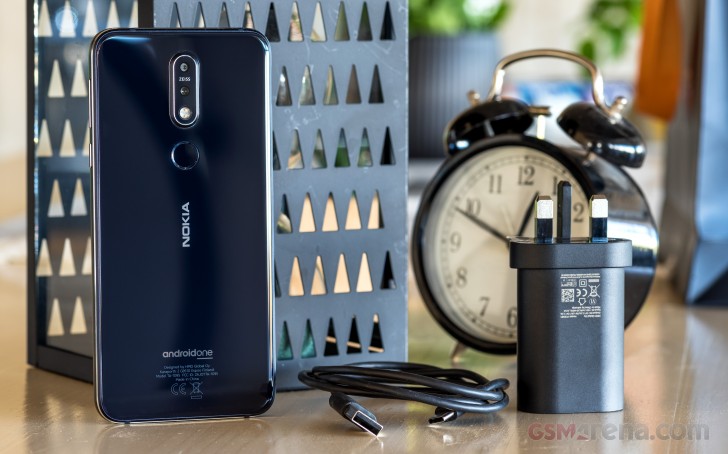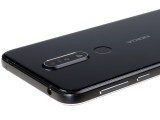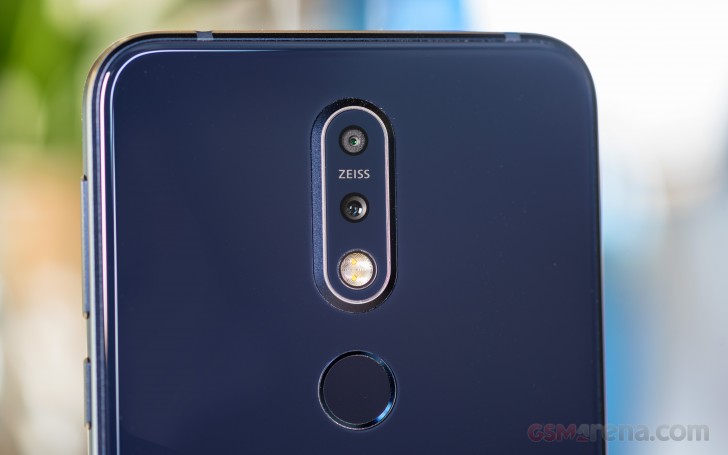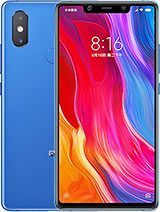Introduction
They say third time's a charm and indeed HMD did right by Nokia's legacy. Once the behemoth of the whole industry, it deteriorated to oblivion, only to be resurrected by Microsoft, and then fall again. Android One turned out to be the platform for Nokia to thrive once more and the latest Nokia 7.1 is the perfect example of how well things are going.
The first HMD-made Nokia phones had great potential, but there was noticeable room for improvement. And with the second generation of Android-powered Nokias we do get more! The Nokia 7.1 is not only well-prepared for the mid-range with its Snapdragon 636 chip and capable dual-camera, but it does impress with a large HDR display.

In addition to the trending display, the 7.1 also features a very sleek shape enhanced by the glass-sandwich design. The phone has enough battery backup with its 3,060 mAh unit, and we are glad to see fast charging support present.
One of the best features about each new Nokia is the Android One system, of course. The 7.1, just like the Nokias to come before it, runs on vanilla Android Oreo and will receive on-time updates for the next couple of years.
Nokia 7.1 specs
- Body: Gorilla Glass 3 front, glass back, 6000-series aluminum frame; 159 g
- Screen: PureDisplay 5.84-inch, 19:9 2280x1080 IPS LCD, 432 PPI, HDR10 compliant
- Rear Camera: 12MP, f/1.8, 1.28µm, PDAF primary, 5MP B&W f/2.4, 1.12µm depth sensor; 1080p video
- Front Camera: 8MP, f/2.0, 84-degree wide angle; 1080p video
- Chipset: 14nm Qualcomm Snapdragon 636, Kryo 260 (4x Cortex-A73 @ 1.8GHz + 4x Cortex-A53 @ 1.6GHz), Adreno 509
- Memory: 3GB/4GB RAM, 32GB/64GB storage + microSD (up to 400GB)
- OS: Android 8.1 (part of Android One, will be upgraded to Android 9 Pie in November)
- Battery: 3,060mAh, 18W quick charging
- Connectivity: 4G, dual-band Wi-Fi 802.11ac, Bluetooth 5.0 aptX, GPS/GLONASS, Wi-Fi Direct, NFC, USB 2.0 Type-C, 3.5mm headphone jack
- Misc: Fingerprint sensor (on the back)
The Nokia 7.1 is touted to be offering the cheapest HDR screen on a mobile phone. And it seems this way - the 7.1 costs about €350 at launch, way less than any current HDR-enabled flagship. And we can't wait to experience it.
Unboxing the Nokia 7.1
The Nokia 7.1 is bundled with an 18W charger and a USB Type-C cable. HMD is also providing a headset in the retail package, but our review bundle is missing this.

The contents of the retail box may vary by region, so we recommend checking with your local Nokia website.
Design
The Nokia 7.1 immediately impresses with its no-nonsense design. It has a very familiar glass-sandwich build, but HMD has added an extra touch by cutting out cut the frame out from a solid piece of 6000-series aluminum.

The 5.84" HDR LCD screen is the most highlighted feature of the Nokia 7.1 and it's an instant attention grabber, alright. The moment we laid our eyes on it we could tell this display has a premium punch compared to the rest of the mid-range gang.

There is a notch on top, obviously, which accommodates the earpiece, the selfie cam, and a bunch of sensors. It's not as large as on the iPhones, and while we can argue a lot whether those cutouts should exist at all, nobody can deny the benefits of the thinner bezels and extra pixels won at the expense of symmetry.
HMD calls the screen PureDisplay and it can upscale SD video content to HDR-like quality. And the maker is praising the panel for its high brightness, of course.

The whole screen is covered by a Gorilla Glass 3 piece, which ends on a subtle 2.5D curve.
There is another glass panel at the back, but HMD doesn't reveal its origin. Still, it's glass, ending on the same subtle 2.5D curve.

The dual-camera is humping at the back and the always-on fingerprint reader is just below it. The camera hump is highlighted by a brushed metal ring.
Nokia's PRs have taken their time to praise the frame. It's been cut out from the single block of aluminum series 6000. It's mostly flat and with a nice brushed finish, though for some reason, it still feels slippery.

Both edges of the frame have been beveled for comfort and grip. Accent paint has been applied to them afterward - copper on the Steel model and Light Blue on the Midnight Blue one.

There isn't anything important that's missing around the Nokia 7.1 - the audio jack and the noise-canceling mic are on top, there is a hybrid SIM slot on the left, and the speaker and the USB-C port are at the bottom.




Nokia 7.1
There is no notification LED, though.

The Nokia 7.1 is quite slim and lightweight for its size. It is as slippery as any other glass phone, but the frame's bevels do boost the grip a bit. The 7.1 is a fingerprint magnet but the dark hues mask those pretty well.
Overall, we've had some very nice experience with the Nokia 7.1 - it's easy to handle, comfortable, and slim and fits in every pocket. The notch isn't as large and the HDR screen is really enjoyable.
Display
The Nokia 7.1 packs a 5.84" IPS LCD screen with a cutout on top and HDR10 support. It has a resolution of 2,280 x 1,080 pixels and they add up for a very decent 432ppi density. There is a Gorilla Glass 3 on top to keep it safe.

HMD has a name for the Nokia 7.1 screen - PureDisplay. In addition to its HDR10 support, it can also upscale to HDR-like quality any SD video in real-time. This can be turned on and off from the screen settings. We tried it and while there is a difference, it's a minor boost in contrast and most of the time barely noticeable.
Then again, native HDR content does look amazing, so the presence of the HDR support is totally worth it.
Being an HDR screen it has to come with jaw-dropping dynamic contrast and it's 1,000,000:1 in case of the Nokia 7.1. We aren't sure what's the official peak brightness, but we measured a maximum one of 600 nits sharp.
Our test showed the maximum brightness you can achieve manually by pushing the slider to the far-right end is 490 nits. This, combined with the deep black levels, led to a very nice static contrast of 1300:1.
We also measured a minimum brightness of just 2 nits.
| Display test | 100% brightness | ||
| Black, cd/m2 | White, cd/m2 | ||
| 0.377 | 490 | 1300 | |
| 0.465 | 600 | 1290 | |
| 0 | 455 | ∞ | |
| 0 | 390 | ∞ | |
| 0 | 590 | ∞ | |
| 0.314 | 461 | 1468 | |
| 0.414 | 470 | 1135 | |
| 0.313 | 460 | 1470 | |
| 0.314 | 481 | 1532 | |
| 0.254 | 432 | 1701 | |
| 0.367 | 469 | 1278 | |
| 0.288 | 429 | 1490 | |
Oddly, the Nokia 7.1 may have one very bright screen, but it did just average in our sunlight legibility test. In real-world terms, the handset remains usable outdoors. Just don't angle it straight towards the sun as it gets almost illegible in these conditions.
Sunlight contrast ratio
The screen supports the DCI-P3 color space but doesn't impress with accuracy. We measured an average deltaE of 6.9 and maximum deviation of 14.2 at point white. There is a noticeably bluish tint. The vanilla Android doesn't offer any color-tuning settings, so this is what you'll be stuck with.
Nokia 7.1 battery life
The Nokia 7.1 is powered by 3,060mAh battery, not the largest we've seen in a phone of this size. It supports 18W fast charging and the supplied charger fills about 45% of a depleted battery in 30 mins.
We ran our usual tests on the Nokia 7.1 and got an overall endurance rating of 80 hours- an average score but in line with the capacity at hand. The individual scores paint a picture of dependability with about 10 hours in each of our screen-on tests (HDR enabled for videos) and 22 hours of talk time.

Our endurance rating denotes how long a single battery charge will last you if you use the Nokia 7.1 for an hour each of telephony, web browsing, and video playback daily. We've established this usage pattern so our battery results are comparable across devices in the most common day-to-day tasks. The battery testing procedure is described in detail in case you're interested in the nitty-gritties. You can also check out our complete battery test table, where you can see how all of the smartphones we've tested will compare under your own typical use.
Loudspeaker
The Nokia 7.1 only has a single, bottom-firing speaker at its disposal. But it can get really loud and sounds quite nice at that.
| Speakerphone test | Voice, dB | Ringing | Overall score | |
| 66.7 | 66.6 | 75.7 | Good | |
| 68.3 | 73.8 | 75.8 | Good | |
| 67.5 | 71.3 | 79.7 | Good | |
| 70.7 | 70.4 | 78.0 | Very Good | |
| 69.2 | 70.6 | 81.6 | Very Good | |
| 67.8 | 70.0 | 84.2 | Very Good | |
| 66.3 | 71.5 | 84.9 | Very Good | |
| 64.8 | 70.5 | 89.9 | Very Good | |
| 69.1 | 74.8 | 81.4 | Very Good | |
| 67.1 | 74.0 | 85.3 | Very Good | |
| 70.1 | 73.1 | 85.4 | Excellent | |
| 70.5 | 74.1 | 85.2 | Excellent | |
| 75.6 | 76.0 | 81.1 | Excellent | |
| 72.8 | 74.7 | 86.6 | Excellent |
Audio quality
The Nokia 7.1 output with an external amplifier was perfectly accurate with no sub-par scores in our test. Loudness was disappointing, though, as is often the case with mid-rangers.
Headphones caused a fair amount of stereo crosstalk to appear, but other than that the output was unaffected. Loudness remained below average, so if you have high-impedance headphones you might struggle to achieve the desired volume levels. If that's not the case you will be happy with the Nokia 7.1's performance.
| Test | Frequency response | Noise level | Dynamic range | THD | IMD + Noise | Stereo crosstalk |
| +0.02, -0.06 | -91.0 | 88.6 | 0.0021 | 0.016 | -94.4 | |
| +0.05, -0.03 | -93.8 | 89.6 | 0.0019 | 0.034 | -54.9 | |
| +0.01, -0.02 | -94.7 | 94.7 | 0.0013 | 0.0086 | -73.1 | |
| +0.12, -0.09 | -93.8 | 93.8 | 0.0035 | 0.115 | -71.7 | |
| +0.01, -0.03 | -93.0 | 93.1 | 0.0037 | 0.0093 | -92.9 | |
| +0.12, -0.06 | -92.3 | 92.5 | 0.0027 | 0.088 | -65.7 | |
| +0.01, -0.02 | -93.6 | 93.6 | 0.0010 | 0.0069 | -93.8 | |
| +0.65, -0.08 | -91.2 | 92.5 | 0.0082 | 0.359 | -50.3 |

Nokia 7.1 frequency response
Pure Android Oreo
The Nokia 7.1 is part of the Android One program - meaning it gets pure Android as seen on the Pixels but on the cheap. The unit we got for review, while running on Android 8.1, already received the latest security patch. Android Pie should around in the upcoming weeks, though.

Android as Google intended shows up when you wake up the phone - clock, notification cards, two shortcuts on the bottom. Ambient display will show you a clock and notifications when you pick up the phone even without waking it up but be sure to enable this feature first.
Fingerprint enrollment uses the standard Oreo interface. Unlocking works as advertised and is quick and reliable.
Past that is the standard Android 8 homescreen with a pull-up app drawer.




Lockscreen • Homescreen • Widgets • App drawer
The quick toggles and notifications shade changes color depending on the wallpaper - white for lighter ones, black for darker ones. The task switcher is the usual rolodex, and wouldn't it be great if Google put the 'clear all' button on the bottom instead of up top? Anyway, multi-window is supported natively since Nougat.




Quick toggles • Notifications • Task switcher • Multi-window
As for multimedia, it's all in the hands of Google's default apps. Photos is in charge of gallery-related tasks and video playback, while Google Play Music is the audio player. There's a file manager with batch actions and Google Drive sync, and Google's Calendar is Nokia's calendar of choice.
FM radio isn't available, though.




Google Photos • Google Play Music • Equalizer • File manager
Performance and benchmarks
The Nokia 7.1 runs on the Qualcomm Snapdragon 636 chipset coupled with 3GB or 4GB of RAM. Our review unit has 3 gigs of RAM and 32GB storage.
The processor in charge of the Snapdragon 636 is an octa-core Kryo 260 CPU clocked at 1.8GHz, while there is an Adreno 509 to handle graphics.

Starting with some pure CPU tests, a.k.a. GeekBench, we see the Snapdragon 636 has plenty of potential. It can pretty-much chew through any every-day task you throw at it. The Snapdragon 660-powered Nokia 8 Plus and Realme 2 Pro run on the same Kryo 260 cores, but with a higher clock frequency and thus post better scores.
GeekBench 4.1 (multi-core)
Higher is better
A single Kryo 260 is one very capable thingy and anyone should be happy with its performance, especially when handling vanilla Android.
GeekBench 4.1 (single-core)
Higher is better
The Adreno 509 GPU as part of the Snapdragon 636 is intended to work smoothly under 1080p screens. And the benchmark scores below show it as one very balanced GPU - not the best one, but one that will serve well for the task at hand.
GFX 3.1 Manhattan (onscreen)
Higher is better
GFX 3.1 Car scene (onscreen)
Higher is better
AnTuTu has always been the one place for all-round performance comparison. The Nokia 7.1 isn't a top-scoring device, but it sure stacks rather well next to the competition. No one can beat Realme's bang for the buck, but the Nokia 7.1 is still delivering enough for its class.
AnTuTu 7
Higher is better
The Snapdragon 636 performs excellent for the class. Its processor has more than enough oomph, while the balanced Adreno 509 does fine under a 1080p+ display. Other benefits are the 14nm manufacturing process, which makes the silicon quite power-efficient and it keeps it cool under peak load.
The wide-spread dual-camera is on the Nokia 7.1
The Nokia 7.1 has a dual-camera on its back, just like most of the smartphones out there. It has a 12MP primary with dual-pixel autofocus, while the secondary 5MP monochrome snapper is just a helper for the portrait and HDR shots.

The Nokia 7.1 has a very nice main camera that's built around a 12MP dual pixel sensor (1.28µm pixel size) behind a bright f/1.8 aperture lens. The 5MP secondary sits behind f/2.4 lens and is only used to extract depth info from the scene. A dual-LED flash completes the setup.
The lenses carry the Carl Zeiss branding, of course, the collaboration between the two companies goes back more than a decade.
HMD has also worked with Carl Zeiss on the processing algorithms. They developed a better blur for the portrait shots based on the Zeiss experience and tried to mimic professional bokeh the best they could with all the tricks - lightning, aperture, lens correction. We'll see how well this works in a minute.
The camera app on the Nokia 7.1 is practically the only piece of custom software on it. Luckily for us, and you, it's been improved since the previous Nokia phones, though the left side of the viewfinder is still overcrowded with various toggles.

Now there is a selfie camera switch on the right side, where it should have been from the start. It's close to your thumb and switching to the 8MP selfie shooter is hassle-free.
There is another big change, too, and it's the mode selector. The camera app is now tailored for swiping between the shooting modes, a way that the iPhones pioneered a long time ago. The available modes are Square, Panorama, Live Bokeh, Pro - left (or down) from the default Photo, and Video, Slow-mo, Time-lapse right (or up) from Photo.




Camera app • Pro mode • Live bokeh • Video
While in the Photo mode you'll get many toggles on the opposite side of the shutter key - flash, timer, single/dual/P-I-P (for combined front/rear shots), beauty, stickers, motion picture, Google Lens, and Settings.


Photo settings • Video settings
The Pro mode lets you pick one of five white balance presets, focus manually, choose ISO (100-3200) and shutter speed (1/500s-4s), or set exposure compensation (-2/2EV in full stop increments).
There is Auto HDR support, which is enabled by default and the option is tucked away in the advanced settings menu.
Image quality
The HMD didn't throw in any fancy features in the Nokia 7.1 camera app. The only thing worth mentioning is the Auto HDR. It works for photos and does what most of the current snappers are doing - multi-stacking. We do suggest leaving this option on as it is by default.
The Auto HDR works well in the daylight scenes and boosts the dynamic range. It rescues some of the blown highlights and improves the contrast, at the expense of some sharpness in the intricate detail such as foliage or building decorations.
In the HDR shots the exposure is even, and the detail is more than enough. The color rendition didn't suffer during the picture stacking process and all photos had true to life vibrant colors.








Nokia 7.1 12MP HDR photos
You can, of course, opt out of the Auto HDR. The photos are captured and saved a bit faster and while they lack the dynamic range of the HDR ones, you'll find them with more and sharper intricate detail. It's not a major improvement and sometimes we even got blurry images, but you should be at least familiar with the differences. You can compare the HDR (above) and the non-HDR (below) shots we took with the Nokia 7.1 by using the embedded compare tool.








Nokia 7.1 12MP regular photos
The Nokia 7.1 lacks optical image stabilization and the bright aperture is the only thing fighting for detail in the dark. The low-light photos are nothing impressive, if not below average. They came out soft and blurry, while the aggressive noise-reduction smeared a lot of the fine detail. Yes, you can see what's in the pictures, but nothing really to brag about with.
We tried turning the Auto HDR on and off for the low-light shots, and it didn't have any effect on the captured images.







Nokia 7.1 12MP low-light photos
The Nokia 7.1 app offers a Pro (manual) mode, where you can tune all important settings. The shutter speed can go as low as 4s, which should be enough for some nice night shots, that is if you can stabilize the phone well enough.


Nokia 7.1 photos shot with Pro mode
And here you can see how the Nokia 7.1 compares against other devices in our extensive pixel-peeking database.



Nokia 7.1 vs. Mi 8 SE vs. Pocophone F1 in our Photo compare tool
Live Bokeh mode (a.k.a. Portraits)
There is one thing HMD is promising for the Nokia 7.1 camera and that's the studio-style portrait shots. HMD hasn't borrowed just the lenses from Zeiss, they also partnered with them to some extent for the bokeh effect as well. We'll spare you the PR talk but let's just say HMD is claiming that it has achieved very good subject separation and pro-like bokeh because of the Zeiss involvement.
The mode is called Live Bokeh and you can adjust the blur strength real-time. It's set at 50% by default.
For starters, the subject separation is indeed impressive, even with messy hair. For a mid-range phone, the Nokia 7.1 has an outstanding separation, even if you put a complex subject before the camera, such as a plant.



Nokia 7.1 Live Bokeh shots
Then there is the whole depth mapping thing. The Nokia 7.1 camera does a great job with the mapping, it knows which object is where and blurs accordingly. That's why you'll see the apples behind the plant less blurred than the background. We just wish that it was clever enough so that it renders the foreground out of focus, too.

Nokia 7.1 Live Bokeh photo
Of course, the Live Bokeh is mostly intended for humans and the algorithms work nicely on those. The separation is accurate, and the blur effect is brilliant. We won't go as far as calling it professional-grade, but it's better than on most of the competitors, some flagships included.




Effect 50% • Effect 100% • Effect 50% • Effect 100%
And here are some more portraits.







Nokia 7.1 Live Bokeh photos
Video recording
The Nokia 7.1 records video up to 2160p. It can obviously also do 1080p, but just at 30fps, there's no 60fps frame rate option. There's electronic stabilization, which only works in 1080p and, like all such implementations, results in a cropped coverage. You can't turn off the stabilization.
2160p videos are recorded with a bitrate of around 41Mbps - that's just about the standard number. 1080p clips get around 20Mbps, that's actually a little more than the average 17Mbps. Audio is recorded in stereo at 256kbps, boosted by Nokia's OZO tech.
The 4K footage is soft in areas with sophisticated detail (foliage, tennis nets), and sharp elsewhere. It's mostly noise free and with true to life colors. The dynamic range is above average and the contrast is excellent.
The 1080p clips is similar in quality, though the picture looks a little bit sharper and they have narrower field of view due to the always-on stabilization.
As usual, we've provided samples straight out of the camera for you to download - 2160p@30fps (9s, 49MB), and 1080p@30fps (9s, 24MB).
Finally, you can use our Video Compare Tool to see how the Nokia 7.1 stacks against the Mi 8 SE and Pocophone F1 when it comes to video capture.



2160p: Nokia 7.1 against the Xiaomi Mi 8 SEand the Pocophone F1 in our Video compare tool
Selfies
The selfie camera of the Nokia 7.1 is an 8MP with an f/2.0 aperture lens, but no autofocus. Its plane of focus is a reasonable distance away from the phone and you don't have to poke the screen with your nose to be in focus, so that's good. Selfies turn out with true skin tones and overall pleasing color rendition, though the level of resolved detail isn't impressive and the quality deteriorates quickly when the light isn't perfect - say indoors.




Nokia 7.1 8MP selfies
Blurred background selfies with just the one cam aren't new anymore, and the 7.1 does them too. And it does them quite well at that. See for yourselves.




Nokia 7.1 8MP selfie portraits
Alternatives
The Nokia 7.1 is shaping as one of the better Android One smartphones with a great display, snappy performance, and an attractive camera. HMD's portrait claims are rather nice, too, but the all-round package still matters more than just one shooting mode.

Luckily, the Nokia 7.1 has it figured all figured out and has one comprehensive specs sheet. It isn't the most powerful smartphone in this price bracket, but balances this with great design and camera.



Xiaomi Pocophone F1 • Huawei Honor Play • Huawei Mate 20 lite
Quite expectedly, the first competitor worth mentioning is the Pocophone F1. It has a rather limited reach, but if available in your region, the F1 is currently one of the sweetest deals on the market with that large display, cutting-edge Snapdragon 845, and great camera package.
Then there is the gaming-oriented Honor Play. It has a large and notched display (no HDR though), powerful Kirin 970 chip, and a larger battery. The camera quality also turned out to be quite nice, so if it's performance you are after and you don't mind a custom ROM, then the Honor Play is worth checking out. Or you can exchange some of the Play's performance punch for better selfie experience with the Huawei Mate 20 Lite.


Xiaomi Mi 8 SE • Samsung Galaxy A8 (2018)
Xiaomi's Mi 8 SE is as compact as the Nokia 7.1 but boasts an HDR AMOLED screen with a notch that houses a 20MP selfie snapper. The Mi 8 SE has a more powerful Snapdragon 710 chip, while its main camera is very similar to the Nokia 7.1's. The Xiaomi runs on MIUI, which may be a bummer for the vanilla Android fans. And it's not as widely available as the Nokia. Still, it's worth considering as it does quite a few things better than the 7.1.
Finally, the most recent Samsung Galaxy A8 costs as much as the Nokia 7.1 but is IP68-rated for water-resistance. It has a better Super AMOLED screen, similar performance, but its dual-camera handles selfies. If you aren't against Samsung's UI, you should give it a try.

The Verdict
Here is the deal - the Nokia 7.1 is far from the best bang for the buck phone on the market. Its strengths lie elsewhere.
The 7.1 is one of the cheapest yet widespread smartphones with an HDR display. Then there is the ZEISS-enhanced dual-camera on the back. Finally, Android One is another thing that can be a major decision-maker. These three are the key features of the Nokia 7.1 wrapped into one beautiful dual-glass presentation.
So, if you are keen on having one of the best Android One phones on the market, go and test the Nokia 7.1 for yourself. You may find it surprisingly fitting if blazing-fast performance isn't a must.
Pros
- Great HDR display
- Dependable battery with fast charging
- Lightweight glass design
- Very good all-round camera experience
- Class-leading portraits
Cons
- No 60fps video recording
- The selfies aren't that great
- Water, or at least splash resistance would have been nice to have


0 Comments